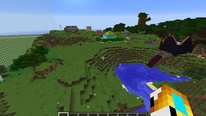- Fengfeng Ke
- http://myweb.fsu.edu/fke/
- Professor
- Mathematical Learning via Architectural Design and Modeling Using E-Rebuild
- https://mileresearch.coe.fsu.edu/erebuild/
- Florida State University
- Chih-Pu Dai
- PhD Student
- Mathematical Learning via Architectural Design and Modeling Using E-Rebuild
- https://mileresearch.coe.fsu.edu/erebuild/
- Florida State University
- Luke West
- Ph.D student
- Mathematical Learning via Architectural Design and Modeling Using E-Rebuild
- https://mileresearch.coe.fsu.edu/erebuild/
- Florida State University
Public Discussion
Continue the discussion of this presentation on the Multiplex. Go to Multiplex









Chih-Pu Dai
PhD Student
Thank you for visiting our video. E-Rebuild is under active design, development, and testing including game artifacts, learning supports, in-situ assessments, and the game level editor.
We are very excited about participating in this discussion and receiving your feedback:
Please feel free to ask questions regarding the project and the video as well.
Sarah Hampton
Fengfeng Ke
James Brown
5/6 STEM Teacher
I like the idea of learning and reinforcing mathematics concepts through a gaming format. How do you plan on recruiting teachers to employ this in their classrooms? If a teacher only has access to Chromebooks, is there an ability to incorporate this in a web based format?
Fengfeng Ke
Professor
HI James,
Thank you for your comment! We have been recruiting teachers through the school district and personal contacts. We have been using E-Rebuild as a web-based platform on Chromebooks (with even the oldest version) for the past years. Teachers and students can employ this in their classrooms as long as the Internet is available. The only feature that is currently in need of a regular desktop/laptop is the level editor.
James Brown
Amy Emmert
I just wanted to say this is fabulous! I especially like the math story component. I have a son who would benefit incredibly from this. Keep up the amazing work!
Fengfeng Ke
Professor
Dear Amy,
Thank you for your encouraging comment!
Devon Russell
Wow this is a great idea! Will you be making this available for parents to implement at home? If so, what do you think the learning curve would be for a parents to get their kids started?
Chih-Pu Dai
PhD Student
Hi Devon, thank you for the great question. This web-based cyberlearning game is available anywhere with access to the Internet. Parents or even kids themselves can play and learn at home. The learning curve is really a great question since learning should not only be fun but also challenging. Thus we have designed learning supports to scaffold the students. In terms of the learning curve of the game actions, from my personal observations with the participants (in groups, individually, face-to-face, and online), the average time spent on the "training levels" is around 30-40 minutes, and this is quite consistent with all the participants I have observed. After the training levels, the participants can generally maneuver smoothly. Nice question! Thank you.
DeLene Hoffner
Devon Russell
Thanks for the answer, I really think this has some great potential. For those that maybe don't have a computer at home but have a tablet do you see it also being available in an app form in the future?
Thanks
Chih-Pu Dai
Fengfeng Ke
Professor
Yes, developing an app for tablet is one of our future goals.
DeLene Hoffner
Program Coordinator
What have you found to be your greatest challenge in this project?
What has been your greatest discovery?
Thank you for all your research, planning, designing and implementation. This seems very motivating for students to build their skills in a variety of ways.
Chih-Pu Dai
PhD Student
Hi DeLene, thank you so much for the nice questions. Speaking as a researcher/ research assistant, I think all the aspects of this project are challenging. The greatest ones are design and implementation in schools. For any cyberlearning projects, sometimes, unpredicted situations happened, for example, the Internet issues, hardware and technology issues; but as different iterations being implemented in this design-based research project, we can gradually address these challenges.
The most fascinating findings for me is the gaming and learning interactions along with the behaviors demonstrated by the participants. In-game actions, and how it interacts with different design features to promote engagement and learning in the game are really interesting to be observed during the gameplay processes. Hopefully, we will have some more sound research findings to be shared in the near future.
DeLene Hoffner
Luke West
Fengfeng Ke
Professor
HI DeLene,
I want to concur with Chih-Pu on the challenge we face in implementing this platform in diverse classroom and learning settings. For example, old-version Chromebook in addition to unstable Internet access in certain classrooms did make us think more on how to balance functionality and aesthetics.
The most fascinating findings for me are not only the positive learning outcomes reinforced by the platform usage but also the dynamic interactions between game features, implementation arrangements, and learner agency.
DeLene Hoffner
DeLene Hoffner
Program Coordinator
Thank you Fengfeng Ke, this is so intriguing. It fascinates me how the interactions engage students.
Michael I. Swart
Thanks for this great work for students. The math history component is so crucial and helps demystify the why's of mathematics. This is great work. Is it a web-based software or local?
Chih-Pu Dai
PhD Student
Hi Michael, thank you so much for the feedback. This is a web-based learning game, you can also find the link to the game above in the title of this video showcase next to the video. I hope you enjoy it.
Stacey Forsyth
Director
I'm curious if the past few months of 'home learning' have impacted how you're using and testing the game. With so many educators and parents looking to keep their kids engaged and learning during this time, it seems like there might be high interest in and demand for interactive math tools such as this. Have you noticed increased usage of the site during this time? What type of support do you provide to educators looking to integrate this tool in their classroom?
Sarah Hampton
Fengfeng Ke
Professor
HI Stacey,
These are all good questions! We did cancel an infield study with the schools this spring due to the Covid-19 situation. We are planning a "home learning" study this summer. There is an increased interest in using the site during this time. We have been hosting regular teacher workshops for teachers who are looking to integrate E-Rebuild in their classroom. We have also shared a series of mini tutorial videos on the web site (https://mileresearch.coe.fsu.edu/erebuild/videos/) based on teachers' request.
Sarah Hampton
Benjamin Walters
Great video—I love the problem-solving aspect related to rebuilding after a natural disaster. It looks like a great project to get middle schoolers engaged in mathematics. I see that you had to cancel an in-field study recently, but has the game had any real-time application in the classroom yet? I was curious as to what part of the game students seem to find the most engaging so far, and have you run into any roadblocks with student/teacher engagement in the classroom? Thanks!
Fengfeng Ke
Professor
HI Benjamin,
Thank you for your comment! We have implemented E-Rebuild in multiple infield studies in the classroom during the past 3 years, when we iteratively studied and refined the design of E-Rebuild. Typically the classroom usage involves game-based learning sessions in a math or a digital literacy class twice a week for 6-8 weeks. So far, students were found to be most engaged with the game actions that allow them to be involved in environmental storytelling, such as building and placing (or arrangement). On the other hand, we found that students tended to adopt a random trial-and-error gameplay strategy and avoided effortful thinking during game-based problem solving. Some of them would not necessarily reflect on or refine their gameplay strategies to be a mindful gamer or problem-solver. Such an observation has pushed us to refine our learning support features to make them better aligned and intrinsically integrated with gameplay to support purposeful problem representation/analysis and story-telling related motivation.
Benjamin Walters
Chih-Pu Dai
DeLene Hoffner
Program Coordinator
How does E-Rebuild enable not only problem-based mathematical thinking and learning, but also participatory design of game-based math problems and adaptive learner support during gameplay? What aspect of the game do you feel creates this learning?
Fengfeng Ke
Professor
HI DeLene,
In E-Rebuild, we have designed game actions (e.g., collection, site survey, building, trading, allocation, and placing) that embody corresponding mathematical practice and problem-solving actions (e.g., identification, measurement, creation, analysis, and evaluation). Based on these core game actions, we design each game task as an authentic and interactive mathematical problem.
E-Rebuild involves a game level editor. This game level editor enables teachers and students to design and generate a new game level (or game-based math problem) based on the current task archetypes, by selecting learning objectives (i.e., specific math competencies aligned with common core mathematics standards), an associated game task archetype, and then the composition and presentation of core parameters in the selected task archetype. With each new game level, in-game learning support that is aligned with the task archetype is also generated dynamically and simultaneously. By using this game level editor, we can encourage both teachers and students to act as participatory designers of math problems for peers and themselves.
Based on a real-time, stealth assessment (or estimate) of a student's math competency profile, E-Rebuild will adapt the game level navigation (or game-based learning trajectory) for each student. At the same time, it will adapt the presentation of in-game learning supports (e.g., step-by-step demonstration, partially demonstration, versus interactive prompting in the Task Planner) based on a student's math competency estimate and his/her task performance (e.g., number of failed trials).
Sarah Hampton
DeLene Hoffner
DeLene Hoffner
Program Coordinator
Thank you very much for your details. Great information. Your project is fascinating.
Fengfeng Ke
Professor
Thank you, DeLene!